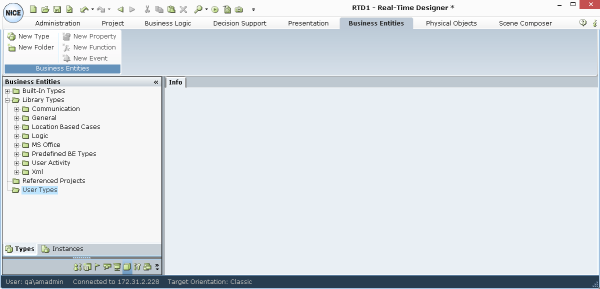You can integrate physical and other objects into data structures that represent the business entities of your organization. Real-Time Designer enables you to define as many business entities as you require by defining the data structures that contain them. These data structures are called business entity types in Real-Time Designer.
After you have defined physical objects (see Physical Objects), you can integrate these objects and others into data structures that represent the business entities of your organization, such as a Transaction, Customer, Call, Policy, Account, Billing Information, Lead, Service Request, Product, or Contact Information.
Real-Time Designer enables you to define as many business entities as you require by defining the data structures that contain them. These data structures are called business entity types in Real-Time Designer. A business entity type can consist of other business entity types and properties. For example, the data structure type of a Customer may contain the data structure type of a Person, Car and/or Account.
To assist you in defining business entities, Real-Time Designer is delivered with predefined business entities listed under Library Types in the Business Entities pane. Use these predefined business entities to define your business entities. See Library Types - Predefined Business Entity Types.
After you have defined business entity types, you can define business entity user instances. A business entity user instance is an instance of a specific business entity type (data structure). For example, a business entity user instance of the business entity type Customer may be an Active Customer, Overdue Customer, or Dormant Customer.
Business entities are managed from the Business Entities pane. To display the pane, click the Business Entities tab on the ribbon.
Two sub-tabs provide the functionality of this window:
Types: Enables you to define the business entity types that define the data structure of a type of entity in your organization, such as the data structure that describes a Customer, Car or Account. See Defining Business Entity Types.
Instances: Enables you to create a specific instance of this specific data structure for a kind of business entity in your organization. For example, an instance of the data type Customer, may be Active Customer, Overdue Customer, and so on.
The instances that you define in these windows only represent a data structure and not the actual data itself. The actual data of these instances is filled out when Real-Time Designer is running in a live agent environment.






